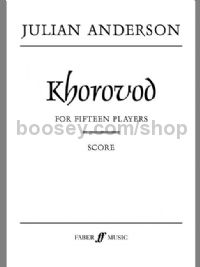Khorovod (Mixed Ensemble)
Khorovod (Mixed Ensemble)
* Estimated price converted from UK retail price
Full Score of Julian Anderson's Khorovod (1994) for chamber ensemble of 15 players.
Published by Faber Music.
Instrumentation: 1(=picc).1.1.1(=cbsn) - 1110 - perc(2): whip/guiro/t.bells/crot/mcas/sleigh bells/vib/5 tpl.bl/4 susp.cym/chinese.cym/hi-hat/SD/ped BD/mar/vibraslap/2tgl/BD/bongos/3 congas/2 tumbas/2 tom-t/anvil/tam-t/referees whistle - pno(=cel) - 2 vln.vla.vlc.db
'The title is the Russian for 'round dance' and refers to a category of melodies celebratory in character, whose most obvious feature is their limitation to a small group of pitches (often just three or four) which are cycled round and round in ever-varied rhythms. Although Khorovod does not quote any Russian, Turkish, Romanian or Lithuanian melodies of this type, about twenty of them were used as models for melodic writing in the piece. The piece is primarily melodic; all the harmony results from sustaining notes of a melody, or from sustaining its harmonics. These subsequently form the basis of new melodies, and so the process continues. Khorovod avoids transitions, consisting in the main of a sequence of dances at various tempos shunted against one another; but as they are also frequently superimposed at different speeds and meters, the texture is often multi-layered. As the composing progressed, references to other folk traditions popped up increasingly, and thus the final result incorporates references to Spanish folk music and even to disco music (I wanted to bring the piece nearer ?home?). The principle dances unfold as follows: 1 a Russian-style khorovod in C played at four speeds simultaneously 2 a brutal Lithuanian-style dance in C sharp inflected towards jazz 3 a Spanish malagueña in D for two marimbas and piano 4 a long slow khorovod in F sharp, which gradually accumulates speed and energy 5 a third, boisterous Russian dance in C sharp leading to 6 a climatic bop in the same key, after the style of ?house? club music, which combines all the elements of the piece in a dense tutti; and finally 7 a concluding lullaby in C on the woodwinds.'
~ Julian Anderson




